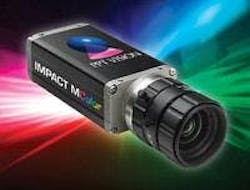Color Cameras
“PPT VISION has many years of experience solving factory automation applications with color IMPACT smart cameras and software,” said Bob Heller, CEO. “The recently released IMPACT M-Series Embedded Vision System is already improving yields and production for many manufacturers, and the new and fast color M-Series cameras now make the system an ideal solution for solving applications that require color image processing.”
Grayscale cameras, like the IMPACT A20, solve the majority of machine vision applications. However, sophisticated color cameras and tools are needed to solve numerous critical inspection and guidance operations for industries ranging from food products to transportation equipment. Color IMPACT M-Series cameras can be used to detect food spoilage and determine the fat content in meat. Other applications solved with PPT IMPACT color vision tools include sorting and identifying pharmaceutical tablets, detecting wire placement and components in electronic products, and many additional possibilities.
The IMPACT M-Series Embedded Vision System allows users to perform up to four unique inspections that can be initiated independently—at different times or simultaneously—utilizing a single vision processor. Significant cost savings are achieved by eliminating the need to purchase multiple systems for separate inspection/guidance programs, and the comprehensive system greatly reduces setup and networking time over the traditional use of multiple systems.
- for sorting, monitoring and identifying color object
- perform up to four unique inspections
- single vision processor
